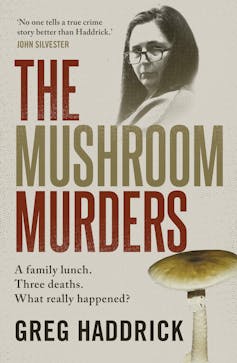Two true crime books on the mushroom trial are out – one is told by a fictional juror
- Written by Rick Sarre, Emeritus Professor in Law and Criminal Justice, University of South Australia

Two books on the recent Erin Patterson trial have just been published, both by experienced true crime writers. Both are meticulously researched (primarily relying on the transcripts of evidence), well written and eminently readable. The timing of their publication is remarkable, given it’s only been a month since the sentencing. Having said that, neither book seems rushed.
Greg Haddrick, who writes from the perspective of “a fictional juror” in The Mushroom Murders, also wrote In the Dead of Night, about the 2020 murder of Russell Hill and Carol Clay in Victoria’s remote Wonnangatta Valley. Duncan McNab, author of Recipe for Murder, is a former detective, a private investigator (specialising in criminal defence) and an investigative journalist.
Review: The Mushroom Murders – Greg Haddrick (Allen & Unwin); Recipe for Murder: The poisonous truth behind Erin Patterson – the mushroom murderer of Leongatha – Duncan McNab (Hachette)
I enjoyed both books immensely – not for the horror of the tale itself, but for the insightful way they tackle this most intriguing story. Neither book offers anything new by way of evidence, as what is written is all on the public record. But readers will nevertheless find a great deal to interest them in the narrative of both authors, especially their descriptions of the legal wranglings and media frenzy.
Haddrick’s imagined perspective as a (female) juror who runs a (fictitious) picture-framing business in Morwell is an intriguing literary device. He is careful to advise readers that he neither approached nor spoke to any of the real jurors. Indeed, the law does not allow such an approach, given the requirement of the confidentiality of their deliberations.
The entire book is narrated by this fictional person. “I wanted readers to feel they were on that journey with the jury,” Haddrick explains in his preface. All the evidence, he says, “comes directly from, and only from, the evidence those jurors heard and saw during the trial”. Some readers may find his choice of storytelling technique somewhat disingenuous, but the narrative gives the book an impressive immediacy.
Haddrick writes, again in his preface: “Like all of us, our narrator has her own strengths, flaws and opinions, and she does speculate. But where she does engage in speculation, it is clearly identified as separate from the evidence that leads to her verdict — and it reveals some surprising insights into police methodology along the way.” True, there is much written about some very impressive policing, but I found none of it surprising.
On the first page of Haddrick’s book, we read: “A family lunch. Three murders. What really happened?” One might opine that it’s a tad misleading to state that a book narrated by a fictional juror and engaging in speculation regarding (her) thought processes can tell us “what really happened”. But this gradual, unfolding narrative from the perspective of an (albeit imaginary) juror remains a compelling tale if the reader is happy to suspend disbelief and see the trial through her (fictional) eyes.
Does this literary device pose an ethical issue? Perhaps so (especially if it leads to misleading understandings of the facts or the law), but in the legal sense there is no difficulty as long as it’s clearly explained.
The setting
On July 29 2023, in the small rural Victorian town of Leongatha, members of Patterson’s extended family sat down for a casual Saturday lunch of beef Wellington. As Haddrick quips in his opening pages, this has become the most talked-about meal since the Last Supper.
The next day, all four guests were hospitalised. Within a week, three of them were dead: Erin’s mother-in-law Gail Patterson, her husband Don Patterson, and Gail’s sister, Heather Wilkinson. Ian Wilkinson, Heather’s husband, was fighting for his life.
When Patterson was arrested and charged with their murders, the case captured media attention around the world. After a trial that lasted 11 weeks and produced 3,500 pages of transcript, a jury of 12 (seven men and five women) determined she had deliberately poisoned her estranged husband’s parents, and his aunt and uncle, leading to the deaths of three of them and the life-threatening illness of the fourth.
As McNab writes,
Patterson’s cruelty in watching four people who had been nothing but kind and loving to her eat a meal she knew would kill them was the ultimate act of betrayal.
Mushroom murders – a fictional juror’s view
Haddrick’s The Mushroom Murders principally tells what was going through the mind of his fictional juror as she heard the evidence. Readers interested in the way criminal evidence is presented will get a clear picture of that process. His speculation of the iterative process that possibly goes through a juror’s thinking as the evidence unfolds is well constructed. But it is only speculative.





